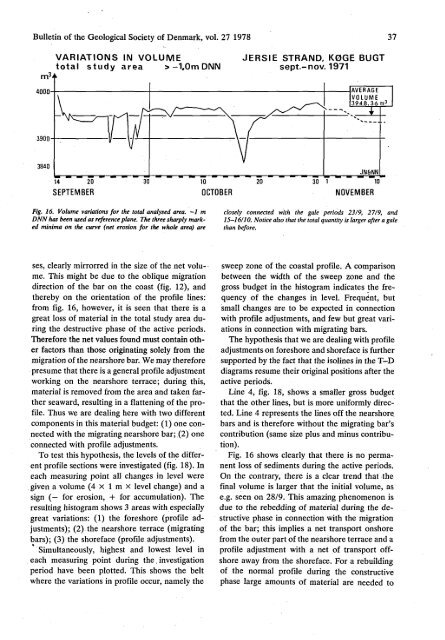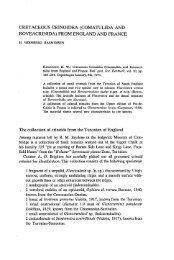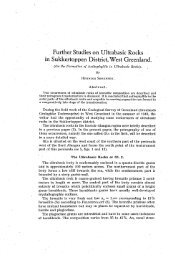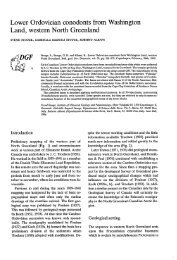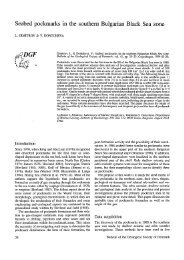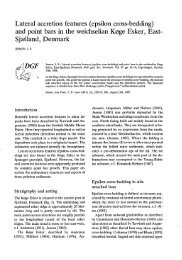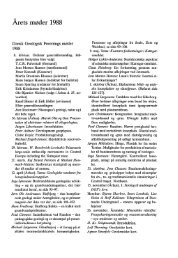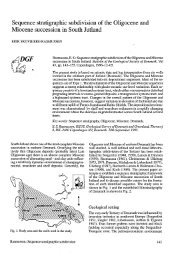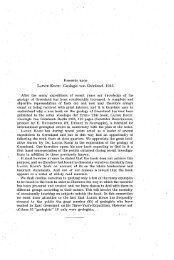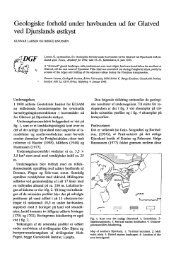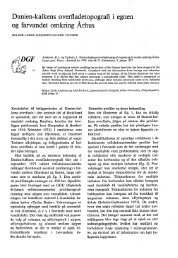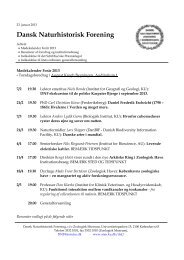Bulletin of the Geological Society of Denmark, Vol. 27/01-02, pp. 15-45
Bulletin of the Geological Society of Denmark, Vol. 27/01-02, pp. 15-45
Bulletin of the Geological Society of Denmark, Vol. 27/01-02, pp. 15-45
You also want an ePaper? Increase the reach of your titles
YUMPU automatically turns print PDFs into web optimized ePapers that Google loves.
<strong>Bulletin</strong> <strong>of</strong> <strong>the</strong> <strong>Geological</strong> <strong>Society</strong> <strong>of</strong> <strong>Denmark</strong>, vol. <strong>27</strong> 1978 37<br />
m J<br />
VARIATIONS IN VOLUME<br />
total study area > -1,0m DNN<br />
JERSIE STRAND, KØGE BUGT<br />
sept.-nov. 1971<br />
AVERAGE<br />
VOLUME<br />
3948.36m :i<br />
4000-<br />
3900-<br />
3840<br />
14 20<br />
SEPTEMBER<br />
30 10<br />
OCTOBER<br />
JN&NN<br />
20 30 1 10<br />
NOVEMBER<br />
Fig. 16. <strong>Vol</strong>ume variations for <strong>the</strong> total analysed area. ~l m<br />
DNN has been used as reference plane. The three sharply marked<br />
minima on <strong>the</strong> curve (net erosion for <strong>the</strong> whole area) are<br />
closely connected with <strong>the</strong> gale periods 23/9, <strong>27</strong>/9, and<br />
<strong>15</strong>-16/10. Notice also that <strong>the</strong> total quantity is larger after a gale<br />
than before.<br />
ses, clearly mirrorred in <strong>the</strong> size <strong>of</strong> <strong>the</strong> net volume.<br />
This might be due to <strong>the</strong> oblique migration<br />
direction <strong>of</strong> <strong>the</strong> bar on <strong>the</strong> coast (fig. 12), and<br />
<strong>the</strong>reby on <strong>the</strong> orientation <strong>of</strong> <strong>the</strong> pr<strong>of</strong>ile lines:<br />
from fig. 16, however, it is seen that <strong>the</strong>re is a<br />
great loss <strong>of</strong> material in <strong>the</strong> total study area during<br />
<strong>the</strong> destructive phase <strong>of</strong> <strong>the</strong> active periods.<br />
Therefore <strong>the</strong> net values found must contain o<strong>the</strong>r<br />
factors than those originating solely from <strong>the</strong><br />
migration <strong>of</strong> <strong>the</strong> nearshore bar. We may <strong>the</strong>refore<br />
presume that <strong>the</strong>re is a general pr<strong>of</strong>ile adjustment<br />
working on <strong>the</strong> nearshore terrace; during this,<br />
material is removed from <strong>the</strong> area and taken far<strong>the</strong>r<br />
seaward, resulting in a flattening <strong>of</strong> <strong>the</strong> pr<strong>of</strong>ile.<br />
Thus we are dealing here with two different<br />
components in this material budget: (1) one connected<br />
with <strong>the</strong> migrating nearshore bar; (2) one<br />
connected with pr<strong>of</strong>ile adjustments.<br />
To test this hypo<strong>the</strong>sis, <strong>the</strong> levels <strong>of</strong> <strong>the</strong> different<br />
pr<strong>of</strong>ile sections were investigated (fig. 18). In<br />
each measuring point all changes in level were<br />
given a volume (4 X 1 m x level change) and a<br />
sign (— for erosion, + for accumulation). The<br />
resulting histogram shows 3 areas with especially<br />
great variations: (1) <strong>the</strong> foreshore (pr<strong>of</strong>ile adjustments);<br />
(2) <strong>the</strong> nearshore terrace (migrating<br />
bars); (3) <strong>the</strong> shoreface (pr<strong>of</strong>ile adjustments).<br />
Simultaneously, highest and lowest level in<br />
each measuring point during <strong>the</strong>. investigation<br />
period have been plotted. This shows <strong>the</strong> belt<br />
where <strong>the</strong> variations in pr<strong>of</strong>ile occur, namely <strong>the</strong><br />
sweep zone <strong>of</strong> <strong>the</strong> coastal pr<strong>of</strong>ile. A comparison<br />
between <strong>the</strong> width <strong>of</strong> <strong>the</strong> sweep zone and <strong>the</strong><br />
gross budget in <strong>the</strong> histogram indicates <strong>the</strong> frequency<br />
<strong>of</strong> <strong>the</strong> changes in level. Frequent, but<br />
small changes are to be expected in connection<br />
with pr<strong>of</strong>ile adjustments, and few but great variations<br />
in connection with migrating bars.<br />
The hypo<strong>the</strong>sis that we are dealing with pr<strong>of</strong>ile<br />
adjustments on foreshore and shoreface is fur<strong>the</strong>r<br />
su<strong>pp</strong>orted by <strong>the</strong> fact that <strong>the</strong> isolines in <strong>the</strong> T-D<br />
diagrams resume <strong>the</strong>ir original positions after <strong>the</strong><br />
active periods.<br />
Line 4, fig. 18, shows a smaller gross budget<br />
that <strong>the</strong> o<strong>the</strong>r lines, but is more uniformly directed.<br />
Line 4 represents <strong>the</strong> lines <strong>of</strong>f <strong>the</strong> nearshore<br />
bars and is <strong>the</strong>refore without <strong>the</strong> migrating bar's<br />
contribution (same size plus and minus contribution).<br />
Fig. 16 shows clearly that <strong>the</strong>re is no permanent<br />
loss <strong>of</strong> sediments during <strong>the</strong> active periods.<br />
On <strong>the</strong> contrary, <strong>the</strong>re is a clear trend that <strong>the</strong><br />
final volume is larger that <strong>the</strong> initial volume, as<br />
e.g. seen on 28/9. This amazing phenomenon is<br />
due to <strong>the</strong> rebedding <strong>of</strong> material during <strong>the</strong> destructive<br />
phase in connection with <strong>the</strong> migration<br />
<strong>of</strong> <strong>the</strong> bar; this implies a net transport onshore<br />
from <strong>the</strong> outer part <strong>of</strong> <strong>the</strong> nearshore terrace and a<br />
pr<strong>of</strong>ile adjustment with a net <strong>of</strong> transport <strong>of</strong>fshore<br />
away from <strong>the</strong> shoreface. For a rebuilding<br />
<strong>of</strong> <strong>the</strong> normal pr<strong>of</strong>ile during <strong>the</strong> constructive<br />
phase large amounts <strong>of</strong> material are needed to


